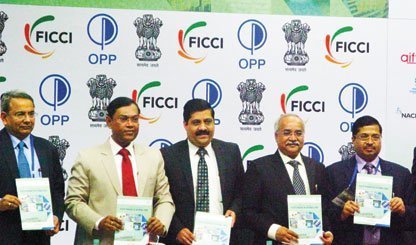
The Federation of Indian Chambers of Commerce and Industry’s (FICCI’s) 2nd National Conference on Packaging Plastic – The Sustainable Choice held in New Delhi on 19 January 2016 was an elaborate affair witnessing the attendance of eminent people from the plastic packaging segment globally. Several students, sponsored by Sabic, were also given the opportunity to attend the conference in the national capital and learn from the industry experts first hand. While the welcome address was conducted by KK Seksaria, president, Plastindia Foundation, the inaugural session was moderated by Vinay Mathur, deputy secretary general, FICCI. Talking about the plastic industry, Mathur says, “Generally when we talk about ‘Make in India’ we tend to skip the point that ‘Make in India’ with zero defect is important and in the case of plastics it becomes even more vital.”
We all know that plastics are playing a very important role in the growth of the economy. In many industrial sectors plastics account for almost 85,000 crores of business in the country, employing about 3.3 million people. But while growth is evident, according to FICCI’s view, we need to be very careful about the disposal, reuse and reprocessing of plastics. The collection of plastics and the problem of mixed garbage and segregation of plastics also needs to be taken care of, adds Mathur.
“This conference, second in the line is focussed on plastic packaging as a sustainable choice given that plastic has acquired a not so welcome focus and is seen as a villain. So it was very essential to have this kind of a conclave where we review what’s happening and how far these allegations are true and what are the ways to encounter the problems and place before the larger society the truth along with discussing the newer developments that are happening and meet the various demands. On these accounts the conference so far is working very well,” says Vijay Habbu, senior vice-president at Reliance Industries.
Congratulating FICCI and the Organisation of Pharmaceutical Producers of India (OPPI) for successfully organizing the conference, Prabh Das, chairman of the FICCI National Petrochemicals Committee and managing director and CEO of HPCL-Mittal Energy, said, “Packaging is the most important tool in the hands of the marketing team. Brands are created by their packaging; in fact many markets owe their existence to the development of packaging.” C Bhasker, president of OPPI said, “Responses from the industry, government and all stakeholders are very encouraging. In fact we had a panel discussion which I think was the most interesting one in many years.”
Latest FICCI report
A report titled Plastic Packaging – The Sustainable Choice prepared in collaboration by Tata Strategic Management Group (TSMG) and FICCI was released at the conference. According to the FICCI report, pegged at US$ 700 billion globally, packaging is one of the fastest growing industries while plastics consists of 42% of packaging including both flexible and rigid packaging. In a developing country like India, it grew at a compound annual growth rate (CAGR) of 16% in the last five years and touched US$ 32 billion in FY 2015. The Indian packaging industry represents 4% of the global packaging industry. However, per capita packaging consumption in India is quite low at 4.3 kilograms, compared to countries like Germany and Taiwan where it is 42 kilograms and 19 kilograms respectively. The Indian packaging industry is valued at over US$ 32 billion.
Industry growth
The FICCI report estimates the packaging industry to grow at 18% per annum wherein flexible packaging is expected to grow at 25% per annum and rigid packaging to grow at 15% per annum. The overall packaging industry in India has a huge growth potential and is expected to reach US$ 73 billion in the year 2020. Growth prospects of end-user segments are leading to rise in the demand of the plastic packaging industry. Demand from the rural sector for packaged products is being fuelled by the increasing media penetration through the means of internet and television. Out of 30,000 processing units, about 75% are in the small-scale sector. The small-scale sector, however, accounts for only about 25% of polymer consumption. The industry also consumes recycled plastic, which constitutes about 30% of total consumption.
zIs plastic harmful?
The plastic industry faces risks and challenges such as growing environmental concern, lack of skilled workforce and segregation of mixed plastic waste among others. Reuse and recycling of plastic remains to be a key step towards fostering sustainability and innovation. Talking about the misconception doing the rounds in the society at large circling around plastic being harmful and not being environment-friendly, Habbu said, “Nothing is wrong with plastic as a material, it’s how people use it. The material is the same plastic that people are happy to use as catheters, implant devices, and in mobile phones, cars and dashboards. When the same plastic is used in these areas people don’t find it a problem, it’s only in the packaging applications that people tend to have problems and that too not with all cases. For example, plastic bottles are quite nicely used and they are recovered as well. However, it is a fact that plastics in the flimsier versions such as carry bags cause littering problems and this leaves an impression that plastics are not good.”
“We need to understand what do we mean by saying plastics is not good. In smaller versions of plastic it is difficult to collect therefore it litters, so to a limited extent plastics is not good. Otherwise in terms of biodegradability, plastic is as difficult to bio-degrade as glasses. So compared to the conventional packaging materials, plastic is no good or no better in terms of biodegradability, added Habbu.
Packaging South Asia is the cooperating media partner for drupa 2016 which is scheduled to be held from 31 May to 10 June at Dusseldorf, Germany.








